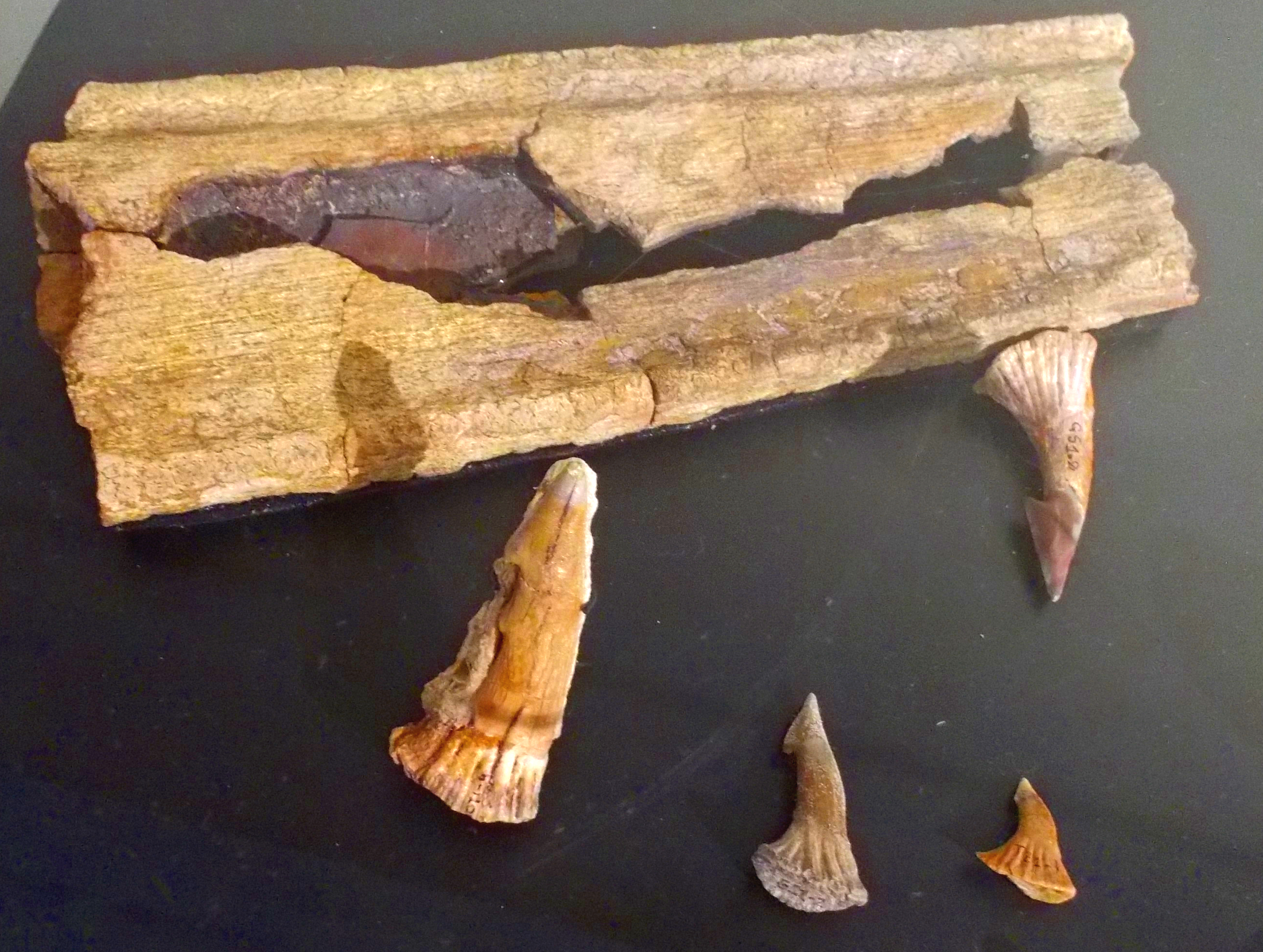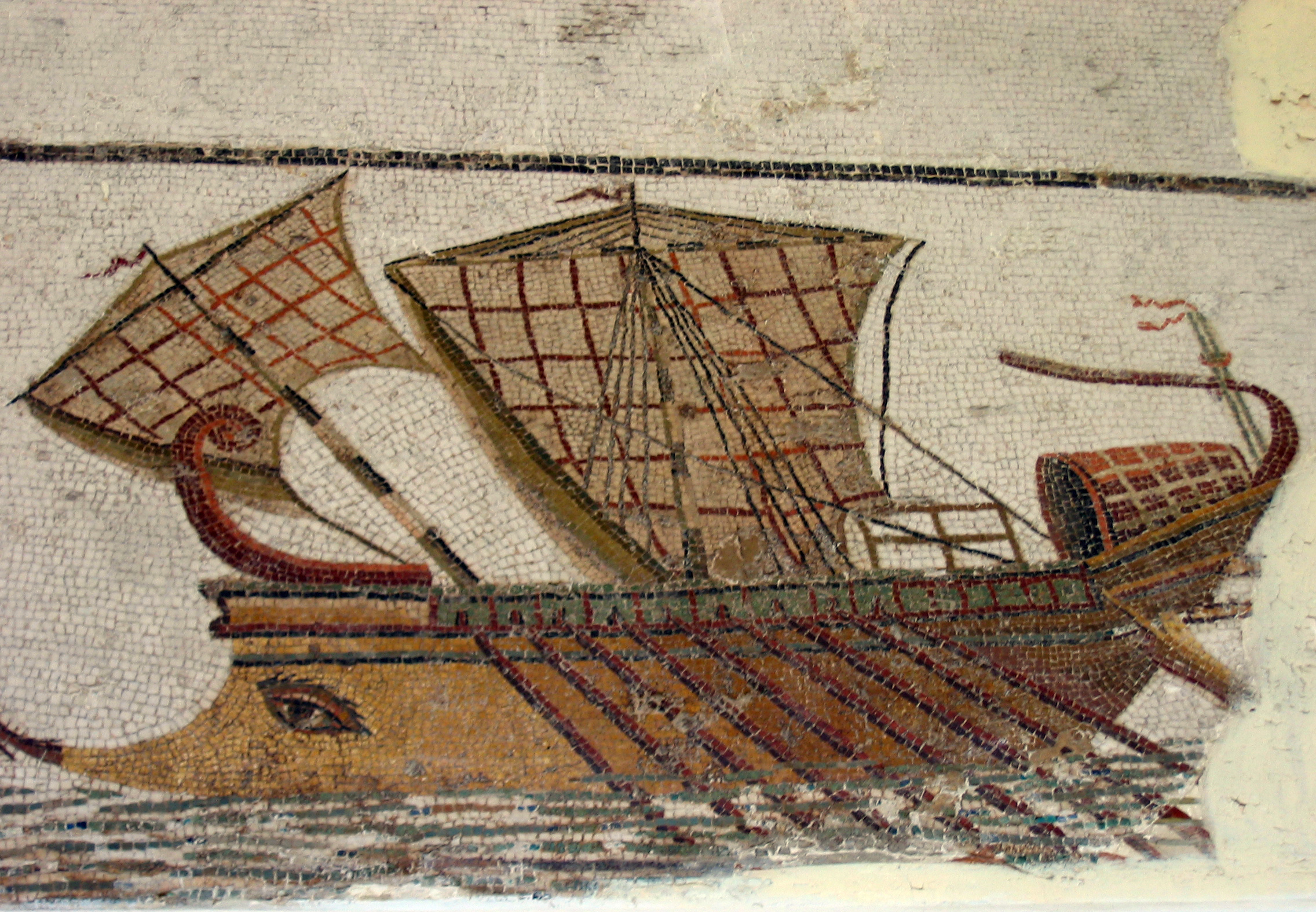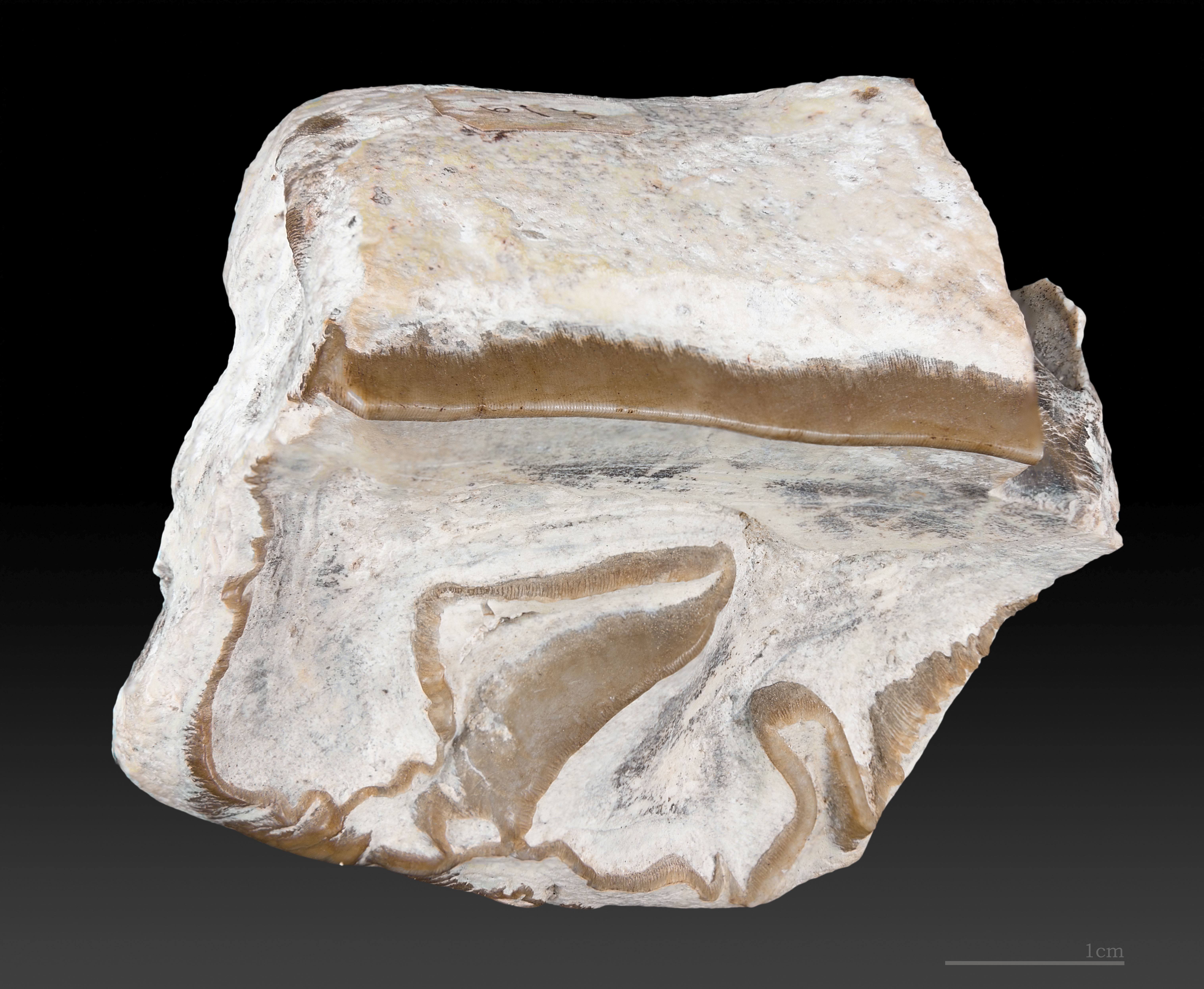|
Lapparentophis
''Lapparentophis'' (meaning " Lapparent's snake") is an extinct genus of terrestrial ophidian known from the Kem Kem Beds of Northwestern Africa (Algeria, Morocco & Sudan) that was first described by Robert Hoffstetter in 1959.Hoffstetter, R. (1959). A terrestrial snake in the Lower Cretaceous of the Sahara n French ''Bulletin de la Société Géologique de France, 7e série'' 1:897-902 Two species are known: the type species, ''L. defrennei'' from Algeria, and a second species, ''L. ragei'' from Morocco, which is only known from the holotype MHNM.KK387 and the paratype MHNM.KK388, two isolated trunk vertebrae. ''Lapparentophis'' is probably the sister taxon of the slightly younger '' Pouitella'' from the Cenomanian of France.Rage, J-C. (1988). A primitive snake in the Cenomanian. n French''C. R. Acad. Sci. Paris, Sér. II.'' 307, 1027-1032 ''Lapparentophis'' was initially believed to have been a snake, but later studies have found it to fall under Ophidia, the clade which Serpe ... [...More Info...] [...Related Items...] OR: [Wikipedia] [Google] [Baidu] |
Pouitella
''Pouitella'' is an extinct genus of terrestrial ophidian known from the Cenomanian of Brézé and Lussant, France and was first described by J-C. Rage in 1988.Rage, J-C. (1988). A primitive snake in the Cenomanian. n French''C. R. Acad. Sci. Paris, Sér. II.'' 307, 1027-1032 Only the type species, ''P. pervetus'' is known and the holotype ( Univ. Paris-VI, no. BRZ 1) consists only of middle trunk vertebrae. ''Pouitella'' was probably the sister taxon of the slightly older ''Lapparentophis'' from the ?Albian-Cenomanian of Algeria, Morocco and Sudan. ''Pouitella'' was initially believed to have been a snake, but later studies have found it to fall under Ophidia, the clade which Serpentes Snakes are elongated limbless reptiles of the suborder Serpentes (). Cladistically squamates, snakes are ectothermic, amniote vertebrates covered in overlapping scales much like other members of the group. Many species of snakes have skull ... also belongs to. References {{Taxonba ... [...More Info...] [...Related Items...] OR: [Wikipedia] [Google] [Baidu] |
Kem Kem Beds
The Kem Kem Group (commonly known as the Kem Kem beds) is a geological group in the Kem Kem region of eastern Morocco, whose strata date back to the Cenomanian stage of the Late Cretaceous. Its strata are subdivided into two geological formations, with the lower Ifezouane Formation and the upper Aoufous Formation used for the strata on the eastern side of the Atlas Mountains ( Tinghir), with the Gara Sbaa Formation and Douira Formation used in the southern Tafilalt region. It is exposed on an escarpment along the Algeria–Morocco border. The unit unconformably overlies Paleozoic marine units of Cambrian, Silurian and Devonian ages and is itself capped by limestone platform rock of Cenomanian-Turonian age. It primarily consists of freshwater and estuarine deltaic deposits. The lower Gara Sbaa Formation primarily consists of fine and medium grained sandstone, while the Douira Formation consists of fining-upward, coarse-to-fine grained sandstones intercalated with siltstone ... [...More Info...] [...Related Items...] OR: [Wikipedia] [Google] [Baidu] |
Ophidia
__FORCETOC__ Ophidia (also known as Pan-Serpentes) is a group of squamate reptiles including modern snakes and reptiles more closely related to snakes than to other living groups of lizards. Ophidia was defined as the "most recent common ancestor of ''Pachyrhachis'' and Serpentes (modern snakes), and all its descendants" by Lee and Caldwell (1998: 1551). The clade name Ophidia derives from the Ancient Greek word (), meaning "small snake". Evolution Modern snakes are thought to have evolved from either burrowing or aquatic lizards during the mid-Cretaceous period, and the earliest known fossils date to around 112 Ma ago. However, the relationship between modern snake and more primitive snake ancestors, many of which retained hind limbs, is less clear. While many of these "stem-snakes" are known from Mesozoic fossils, some of them may be descendants of the earliest true snakes rather than more primitive lineages. Below is a cladogram modified from a study by Wilson ''et al.'' ... [...More Info...] [...Related Items...] OR: [Wikipedia] [Google] [Baidu] |
Early Cretaceous
The Early Cretaceous (geochronology, geochronological name) or the Lower Cretaceous (chronostratigraphy, chronostratigraphic name) is the earlier or lower of the two major divisions of the Cretaceous. It is usually considered to stretch from 143.1 Megaannum#SI prefix multipliers, Ma to 100.5 Ma. Geology Proposals for the exact age of the Barremian–Aptian boundary ranged from 126 to 117 Ma until recently (as of 2019), but based on drillholes in Svalbard the defining Anoxic event#Cretaceous, early Aptian Oceanic Anoxic Event 1a (OAE1a) was dated to 123.1±0.3 Ma, limiting the possible range for the boundary to c. 122–121 Ma. There is a possible link between this anoxic event and a series of Early Cretaceous large igneous provinces (LIP). The Ontong Java Plateau, Ontong Java-Manihiki Plateau, Manihiki-Hikurangi Plateau, Hikurangi large igneous province, emplaced in the South Pacific at c. 120 Ma, is by far the largest LIP in Earth's history. The Onto ... [...More Info...] [...Related Items...] OR: [Wikipedia] [Google] [Baidu] |
Late Cretaceous
The Late Cretaceous (100.5–66 Ma) is the more recent of two epochs into which the Cretaceous Period is divided in the geologic time scale. Rock strata from this epoch form the Upper Cretaceous Series. The Cretaceous is named after ''creta'', the Latin word for the white limestone known as chalk. The chalk of northern France and the white cliffs of south-eastern England date from the Cretaceous Period. Climate During the Late Cretaceous, the climate was warmer than present, although throughout the period a cooling trend is evident. The tropics became restricted to equatorial regions and northern latitudes experienced markedly more seasonal climatic conditions. Geography Due to plate tectonics, the Americas were gradually moving westward, causing the Atlantic Ocean to expand. The Western Interior Seaway divided North America into eastern and western halves; Appalachia and Laramidia. India maintained a northward course towards Asia. In the Southern Hemisphere, Aus ... [...More Info...] [...Related Items...] OR: [Wikipedia] [Google] [Baidu] |
Robert Hoffstetter
Robert Julien Hoffstetter (11 June 1908 in Fargniers – 29 December 1999 in Gennevilliers) was a French taxonomist and herpetologist who was influential in categorizing reptiles Reptiles, as commonly defined, are a group of tetrapods with an ectothermic metabolism and Amniotic egg, amniotic development. Living traditional reptiles comprise four Order (biology), orders: Testudines, Crocodilia, Squamata, and Rhynchocepha .... He described the snake families Bolyeriidae and Madtsoiidae. Selected bibliography *''Faune du gisement précolombien d'Anse-Belleville: Reptiles'', 1946 *''Les mammifères pléistocènes de la république de l'Equateur'', 1952 *''Notice sur les titres et travaux scientifiques'', 1955 *''Contribution à l'étude des Orophodontoidea, gravigrades cuirassés de la Patagonie'', 1956 *''Le gisement de ternifine'', 1963 *''Historique et géologie'', 1963 *''Révision des Artiodactyles de l'Eocène moyen de Lissieu (Rhône)'', 1972 *''Rongeurs caviomorphes de ... [...More Info...] [...Related Items...] OR: [Wikipedia] [Google] [Baidu] |
Albert-Félix De Lapparent
Albert-Félix de Lapparent (; 1905–1975) was a French people, French Palaeontology, palaeontologist. He was also a Society of Saint-Sulpice, Sulpician priest. He undertook a number of fossil-hunting explorations in the Sahara desert. He contributed to knowledge about dinosaurs and other prehistoric creatures. In 1986, José Bonaparte named the dinosaur ''Lapparentosaurus'' in his honour. Dinosaurs named by Lapparent were ''Inosaurus tedreftensis'' (Lapparent, 1960) and ''Lusitanosaurus liassicus'' (Lapparent and Zbyszewski, 1957). New species of known genera are also credited to him. In alphabetical order, they are: ''Lourinhasaurus, Apatosaurus alenquerensis'' (Lapparent and Zbyszewski, 1957), ''Astrodon, Astrodon pusillus'' (Lapparent and Zbyszewski, 1957), ''Lusotitan, Brachiosaurus atalaiensis '' (Lapparent and Zbyszewski, 1957), ''Brachiosaurus nougaredi'' (Lapparent, 1960), ''Cetiosaurus, Cetiosaurus mogrebiensis'' (Lapparent, 1955), ''Elaphrosaurus, Elaphrosaurus gautieri' ... [...More Info...] [...Related Items...] OR: [Wikipedia] [Google] [Baidu] |
Genus
Genus (; : genera ) is a taxonomic rank above species and below family (taxonomy), family as used in the biological classification of extant taxon, living and fossil organisms as well as Virus classification#ICTV classification, viruses. In binomial nomenclature, the genus name forms the first part of the binomial species name for each species within the genus. :E.g. ''Panthera leo'' (lion) and ''Panthera onca'' (jaguar) are two species within the genus ''Panthera''. ''Panthera'' is a genus within the family Felidae. The composition of a genus is determined by taxonomy (biology), taxonomists. The standards for genus classification are not strictly codified, so different authorities often produce different classifications for genera. There are some general practices used, however, including the idea that a newly defined genus should fulfill these three criteria to be descriptively useful: # monophyly – all descendants of an ancestral taxon are grouped together (i.e. Phylogeneti ... [...More Info...] [...Related Items...] OR: [Wikipedia] [Google] [Baidu] |
Maghreb
The Maghreb (; ), also known as the Arab Maghreb () and Northwest Africa, is the western part of the Arab world. The region comprises western and central North Africa, including Algeria, Libya, Mauritania, Morocco, and Tunisia. The Maghreb also includes the territorial dispute, disputed territory of Western Sahara. As of 2018, the region had a population of over 100 million people. The Maghreb is usually defined as encompassing much of the northern part of Africa, including a large portion of the Sahara Desert, but excluding Egypt and the Sudan, which are considered to be located in the Mashriq — the eastern part of the Arab world. The traditional definition of the Maghreb — which restricted its scope to the Atlas Mountains and the coastal plains of Morocco, Algeria, Tunisia and Libya — was expanded in modern times to include Mauritania and the disputed territory of Western Sahara. During the era of al-Andalus on the Iberian Peninsula (711–1492), the Maghreb's inhabita ... [...More Info...] [...Related Items...] OR: [Wikipedia] [Google] [Baidu] |
Type Species
In International_Code_of_Zoological_Nomenclature, zoological nomenclature, a type species (''species typica'') is the species name with which the name of a genus or subgenus is considered to be permanently taxonomically associated, i.e., the species that contains the biological Type (biology), type wiktionary:en:specimen, specimen (or specimens). Article 67.1 A similar concept is used for suprageneric groups and called a type genus. In botanical nomenclature, these terms have no formal standing under the International Code of Nomenclature for algae, fungi, and plants, code of nomenclature, but are sometimes borrowed from zoological nomenclature. In botany, the type of a genus name is a specimen (or, rarely, an illustration) which is also the type of a species name. The species name with that type can also be referred to as the type of the genus name. Names of genus and family ranks, the various subdivisions of those ranks, and some higher-rank names based on genus names, have suc ... [...More Info...] [...Related Items...] OR: [Wikipedia] [Google] [Baidu] |
Paratype
In zoology and botany, a paratype is a specimen of an organism that helps define what the scientific name of a species and other taxon actually represents, but it is not the holotype (and in botany is also neither an isotype (biology), isotype nor a syntype). Often there is more than one paratype. Paratypes are usually held in museum research collections. The exact meaning of the term ''paratype'' when it is used in zoology is not the same as the meaning when it is used in botany. In both cases however, this term is used in conjunction with ''holotype''. Zoology In zoological nomenclature, a paratype is officially defined as "Each specimen of a type series other than the holotype.", ''International Code of Zoological Nomenclature'' In turn, this definition relies on the definition of a "type series". A type series is the material (specimens of organisms) that was cited in the original publication of the new species or subspecies, and was not excluded from being type material ... [...More Info...] [...Related Items...] OR: [Wikipedia] [Google] [Baidu] |






